Bucktail Jigs, Also Known As Hair Jigs, Are Smallmouth Fisherman's Secret Weapons
Don't Think For A Minute Largemouth Won't Eat 'Em Too!
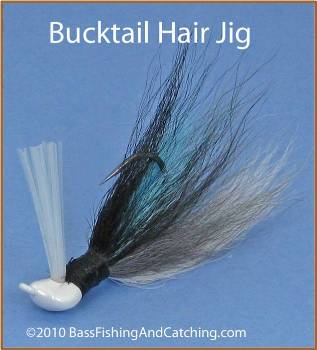
Bucktail jigs will catch most any fish that swims. But they are especially effective on smallmouth bass, which hang out in clear, cool water in highland reservoirs and fast running rivers and streams. Smallmouth will take a hair jig even in the cold water period when most of us think they're laying dormant on the bottom too drained of energy to eat. Wrong!
They're never too lethargic to eat, just to chase. So put a bucktail jig in close to their face and "slurp", they'll take it. Oh yea, largemouth bass will bite them too, even in cold water.

So Just What Is A "Bucktail Jig"?
Bucktail jigs were catching bass long before the presently popular rubber and silicone skirted jigs made their appearance. As the name implies, they have as one main component, hair. Most often it's deer hair that comes from a deer's tail.
Like most other jigs, the head of a bucktail fishing lure is usually lead and most often ball shaped, though sometimes they're in other configurations such as cones, aspirins, minnow heads or footballs. As for the body? Historically, real animal hair and feathers have been used. This included, though was not limited to, deer, rabbit, bear (difficult to come by), turkey and duck hair and feathers. Today, there are synthetic fibers (craft hair) that work very well and are more durable, so they withstand the ravages of a bass' sometimes vicious strikes.
Natural or Synthetic Hair, Which Is Best? There are positives and negatives to both the natural and synthetic categories of "hair" for jigs.
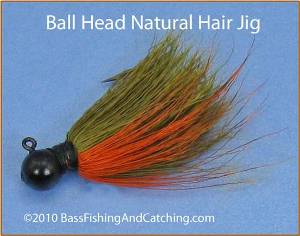
- Bucktail Hair - Individual deer hairs are hollow so they readily "move" in the water. There are primarily two types of hair in the "flag" or tail of a deer. One is the very white, straight hairs that are subject to crimping like a soda fountain straw. The other hair is more limber. It also has an "appearance" of crinkling along the shaft sort of like a french fry. The latter are the better deer hair for "bass" bucktail jigs. I feel they have more "movement" than stiffer hairs. Deer hair is very receptive to color dying. You can find it in many colors and unlike many "craft hairs" it will regain its form after drying.
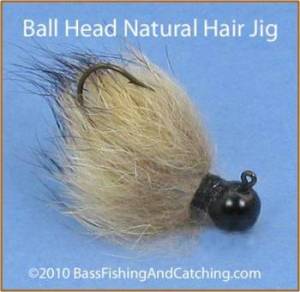
- Rabbit hair - The number of hairs in a rabbit jig, by the very nature of rabbit hair, are far in excess of those in a buck or bear hair jig. Additionally, rabbit hairs, if not cut too short, tend to move enticingly under water in a very lifelike manner imitating the subtle movements of baitfish. It has what might be called a "puff" or "fluff" when the jig comes to a stop. That is, the hair flares out with a subtlety that mimics the fin and gill movement of baitfish and this appeals to bass.
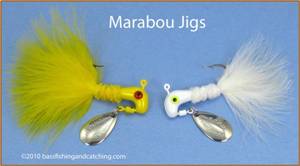
- Marabou - Today, this is a term used for very fine, fluffy, natural material that comes from turkey feathers. However, it originated as the word for describing the very soft, feathery material found along the under-tail covert feathers of the Marabou Stork found in Africa. Once under water, marabou jigs are known for their movement, which imparts action remarkably life-like.
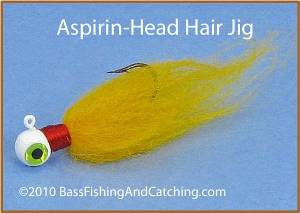
- Synthetics and Craft Hair - There are numerous top notch anglers that swear by the many non-natural craft hairs now available over natural hair. They feel it's finer form gives off more action than natural hair, which they see as stiffer. Technology has progressed to the point that synthetics are often less expensive than naturals. They're also available in many more diameters, lengths and colors than naturals and are consistent in form and color year after year. Consistency is understandably difficult with natural materials. However, there are anglers who feel mass produced craft hair jigs are no where close to hand-tied natural hair jigs in performance. They also find it difficult to work with when tying their own jigs.

Remember, It's What Works Best For You!
As with most things in bass fishing, you must decide what material, natural or synthetic hair, works best in your hands. That's one of the great things about bass fishing. There are few absolutes relative to the many tools of the sport or the techniques in which they are used. Each of us creates his/her own methodology for bass fishing success. We do this by our personal choices, through own our trial and error experiences, successful and unsuccessful. In bass fishing there is never "one way" to do anything. There is always your way and the other guys way.
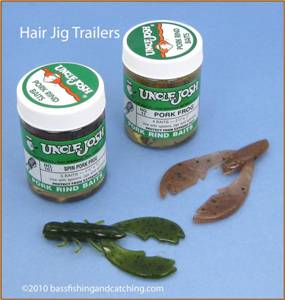
Trailers and Hair Jigs
Beyond the head and body of bucktail jigs are there "trailers"?. Are they used with hair jigs? Absolutely they are, both plastic and pork. Both add buoyancy and bulk, which slows the jig's fall and gives bass substance to hold on to till the angler detects the bite.
Arguably,the most popular size "bass" hair jig is 1/4 ounce followed closely by a 3/8 ounce size. A 2 1/2" #11 or 1 7/8" #101 Uncle Josh pork rind work great on these hair jigs. In cold water the small 1 1/2" #18 has gained popularity. For smallmouth the Uncle Josh twin-tail #U2 is hard to beat. When using pork choose those which have a thin skin. Check out the pieces in the jar before you buy them.
Netbait's "Tiny Paca Chunk" is a good plastic choice as are Zoom's "Swimming Chunk" and "Ultravibe Chunk". Berkley's 3" "Chigger Craw" or "Chigger Chunk" are also good choices. These trailers work well when threaded on he hook rather than merely impaled on the hook. This adds to the jigs bulk while maintaining a compact offering for the bass. When daytime fishing in rivers and streams some river rats choose to fore-go the trailer. They feel it creates too much drag, though they will use one at night.
A good rule of thumb is to try, when fishing reservoirs, to keep your hair jig, including skirt (trimmed back to the hook) and trailer, no longer than 4", with 3 1/2" being even better.
Why Are Bucktail Jigs Effective?
To answer this question we must take a look at how baitfish move and behave and how this appears to bass. Baitfish, minnows, move straight, directly, without a lot of gyrations like most crankbaits we fish do. Their movement is for the most part smooth and flowing, not herky-jerky.
The slim shape of a bucktail jig is that of a minnow profile that strongly imitates baitfish. The soft, wavy action of the hairs move like the soft movement of the gill and fins of minnows. The hair strands breathe, fluff out as the jig stops and wave gently in reaction to the motion of the water when the jig is at rest. Why wouldn't a bass want to eat it?
Reservoirs, Rivers, Streams and Bucktail Jigs
Reservoirs
Hair or bucktail jigs are recognized as better producers in clear water lakes and reservoirs with sparse cover than in those that are off color and filled with wood, weeds and other cover. Highland reservoirs that are characterized by an abundance of rock are good places for fishing bucktail jigs. These waters offer many rocky points, 45° sloping banks and rocky humps. Prime territory for working a jig in cold water.
Lighter jigs, which sink slowly, are preferred when fishing reservoirs. It is beneficial to have a hair jig drift slowly down from one ledge or structure to another with the hair waving and tempting lurking bass.
Rivers and Streams
Current is always an attraction to bass. Where there is current, there are usually bass. Bucktail jigs, particularly 1/4oz and 3/8oz sizes, are a great choice for fishing in current because they offer much less water resistance than do comparable silicone or rubber skirted jigs. Consequently, the jig weight and thin hair drops the jig to the bottom more quickly.
That's where the bass are holding in rivers and streams, lying in wait by stumps, boulders or sand and gravel bars. That's where you want your jig to go as quickly as possible. Also target eddies, rocky drop offs next to deep holes, points be they wood, weeds or rock, and transitional areas where soft sandy bottoms meet chunk rock or rocky ledges.

How Do You Fish Bucktail Jigs?
Bucktail jigs are one lure category whose bass attracting action depends to a great extent on the angler's skill in rod manipulation. You can hop, pop, drag or swim hair jigs in reservoirs, rivers and fast moving streams.
Reservoirs
When fishing bucktail jigs in cold water think "sloooow". Remember as well, to maintain constant contact with the jig, that is, keep a "tight" line between you and your jig so you don't lose the "feel".
- Crawl The Bottom Bucktail jigs are excellent for hugging bottom contours of rocky reservoirs, their points and submerged humps or slowly working the many 45° banks found in highland reservoirs. Your retrieving the jig slowly and in continual contact with the bottom. This approach more closely imitates crawfish, not baitfish so choose your colors accordingly.
- Lift And Drop - When fishing deeper structure with a bucktail jig, be it a point, dropoff, 45° bank or underwater hump, cast past your target and let the jig drop to the bottom. When your line goes slack the jig is on bottom. Now position your rod at about the 10:00 position and and reel up any slack. Raise your rod tip smoothly to the 11:00 position then let your jig drop again to the bottom. Repeat this action till you have covered your target. As often happens any time you're lifting and dropping a jig, or any other lure for that matter, strikes will happen on the fall. Watch your line!
- Horizontal Retrieves Mimic Baitfish - This is "swimming" the jig just above the bottom. That is, reeling slowly and constantly with your rod tip held in a constant position. Your moving the jig by reeling, not manipulating the rod.
Rivers and Streams
One thing you might want to do when fishing hair jigs in these waters is to leave the hair long. Don't trim it back to the hook as you would when fishing reservoirs. This extra length contributes to more action interacting with the current and a closer resemblance to the slim profile of a baitfish.
- Pop That Hair Jig - This retrieve targets bass holding close to objects that have current breaking around them. This could be boulders, logs or any object that provides an ambush point for bass from which they can grab anything edible that seeps by in the current.
- Hop It Over and Around Cover - Large rocks, boulders, sand bars, laydowns all have current sweeping around them. Cast your jig to them, let it fall to the bottom, without allowing a bow to develop in your line. Then lift your rod tip to the 11:00 o'clock position effectively hopping the jig off the bottom. Drop your rod tip to the 9:00 o'clock position and reel up your slack. Repeat the lift/drop till back to the boat or shore if your out of your boat fishing a hole. If your line jumps or you feel a tap, set the hook.
- Swim Them Like Baitfish - Not as easy to do as in reservoirs but it can be done. Cast upstream then retrieve the jig at the same speed as the current so it moves just above the stream or river bed as it moves downstream with the current. Once it passes the 12:00 point retrieve it back to you across the current.
- Drifting A Hair Jig - involves casting upstream and letting the current bounce the jig downstream along the bottom. When the lure reaches the 12:00 position (directly in front of and perpendicular to the flow), there should be a distinct "tug or tick" as the jig rotates to face into the current. It will begin to wiggle against the current as it rises just above the bottom. This is often the point when you get bit.
Tackle Considerations
A balanced spinning rod and reel rig combined with light (6-pound or 8-pound monofilament or fluorocarbon) line is a good choice for bucktail jigs that don't exceed 1/4oz. The rod should be medium fast and a length that best suits your style between 6'and 7' in length. A rod that is fast and has a delicate tip will give you the edge in feeling what are often faint bites with small hair jigs. Many bass anglers who fish bucktail jigs will move to a baitcasting outfit if their jig exceeds 1/4oz. It's really a personal preference if you're not fishing in slop.
I choose to use spinning rigs for all my hair jig fishing. There have been great advances in the technology of fishing rods and reels and these days you can usually create a spinning outfit for most any application, other than flippin' and pitchin' heavy cover.
Go Back To Fishing Jigs From Bucktail Jigs
